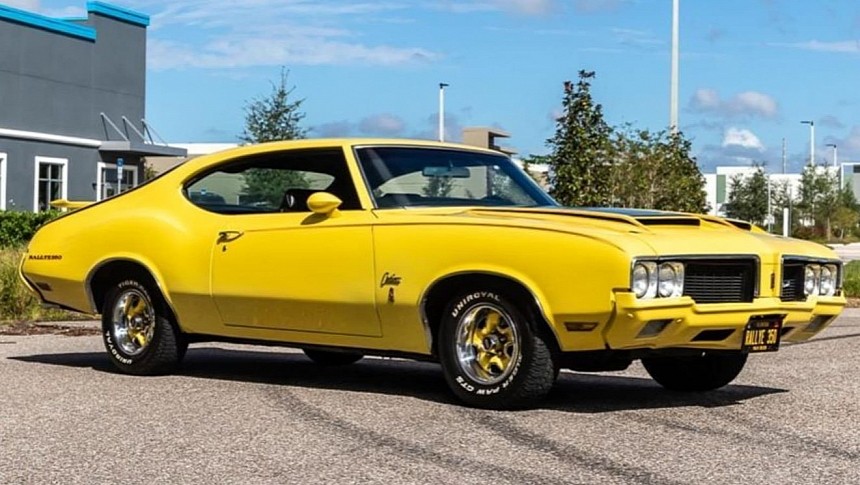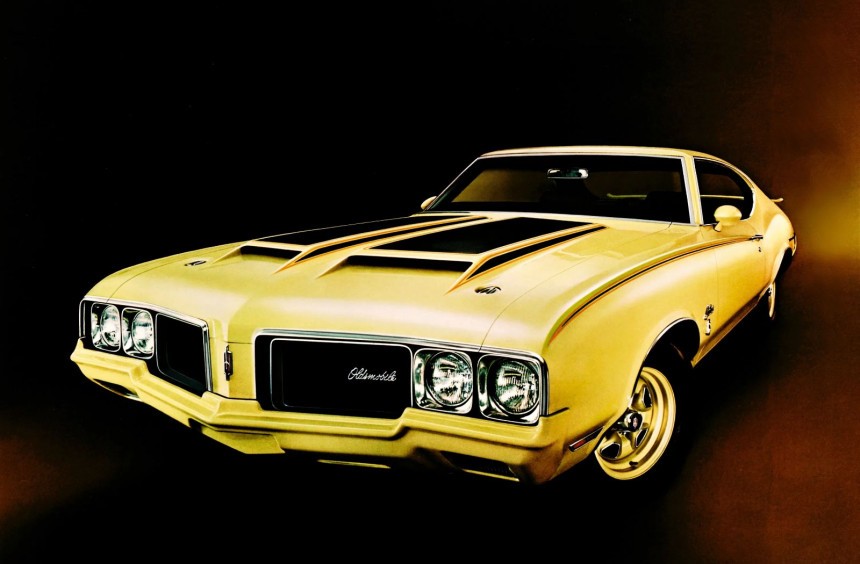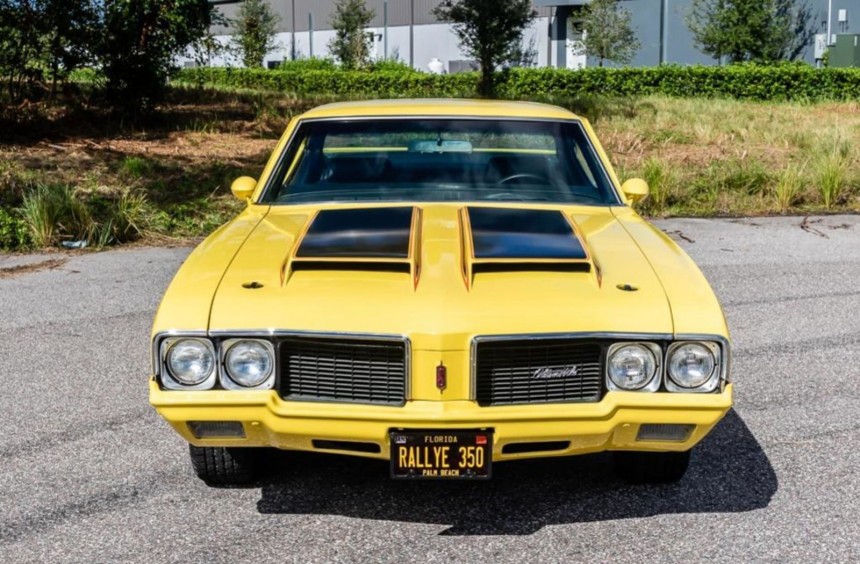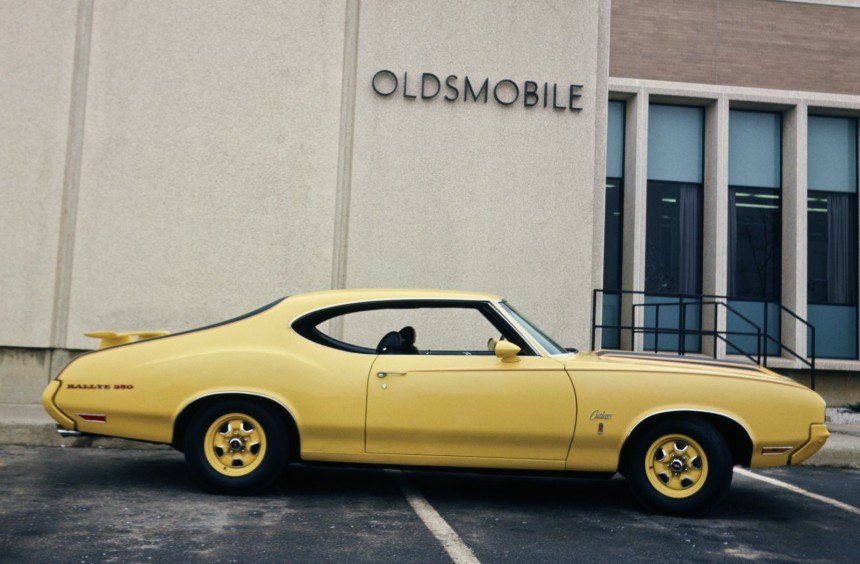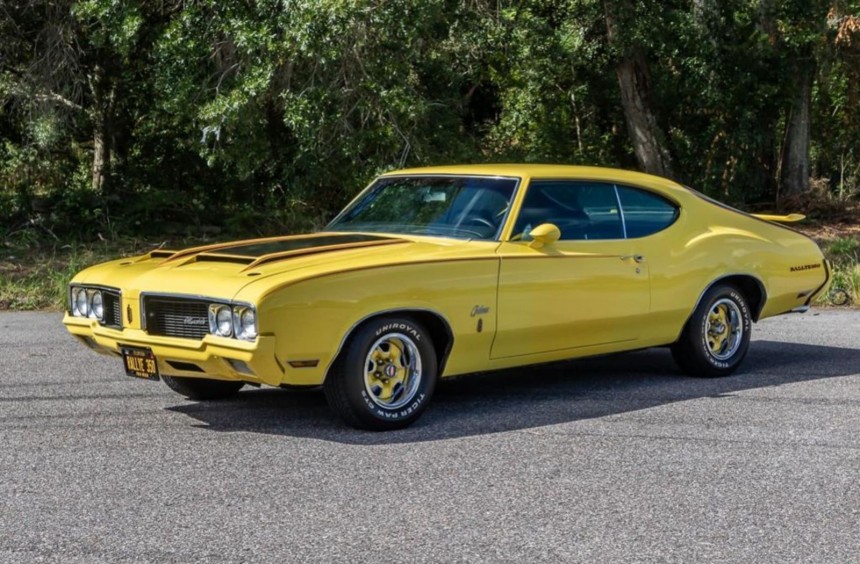The upscale GM division's take on an affordable muscle car, the Rallye 350's all-yellow appearance, was too much for most potential buyers in 1970, but today, it's a gorgeous classic that can be had for used Toyota Camry money.
Founded as Olds Motor Vehicle Company by Ransom E. Olds in 1897, Oldsmobile became a General Motors division eleven years later.
For the next 96 years, the brand stood in the middle of GM's five divisions, offering more upscale models than Chevrolet and Pontiac but less luxurious than those marketed by Buick and Cadillac.
Like all other GM stablemates (except Cadillac), Olds ate a piece of the muscle car pie during the 1960s and early 1970s by offering several performance-oriented derivates of its Cutlass intermediate.
The division's most famous muscle cars were the 4-4-2 and the Hurst/Olds, but for one year only, there was a third, more budget-friendly offering.
The year was 1970, and horsepower-wise, the muscle car era had reached its peak.
GM had just lifted its self-imposed ban that limited the use of V8 larger than 400 cubic inches (6.5 liters) on intermediate platforms, which gave birth to legendary rides like the 1970 Chevelle SS 454 or the 455-powered Buick GSX.
Oldsmobile followed suit by offering its own 455-ci (7.5-liter) Rocket V8 as standard in the 4-4-2.
But, 1970 also signaled the rise of insurance rates, that, coupled with upcoming regulation changes and rising fuel costs, meant that owning one of the most potent muscle cars was no longer affordable for everyone, particularly the younger demographic.
To offer a less-expensive alternative to its younger, muscle car-loving clientele, Olds introduced a new model called Rallye 350.
Essentially, the Rallye 350 was a $158.98 appearance package available for the Cutlass S Holiday, Cutlass Sports Coupe, or the F-85 Sports Coupe.
When checking the W45 option box on the order sheet, the car received a multitude of unique styling upgrades.
These included a Sebring Yellow paint, 14-inch Styled Super Stock II sports wheels finished in the same color, a fiberglass hood with functional air intakes, blacked-out grilles, Rallye 350 decals, a side stripe package, body-colored, Eurothane-coated bumpers and a four-spoke sport steering wheel.
All these upgrades made the Olds look like a radical muscle car, but the W45 option also added some decent performance-oriented hardware like 4-4-2-style dual exhausts, a 3.23:1 ratio rear axle, and the heavy-duty Rallye-Sport Suspension.
Under the hood, the Rallye 350 hid a high-compression 350ci (5.7-liter) Rocket V8 equipped with a Quadrajet four-barrel carb. Linked to a standard three-speed manual, the engine could produce a healthy 310 hp and 390 lb-ft (529 Nm) of twist.
While buyers could get an optional M20 four-speed manual or a three-speed TH350 automatic, the 350 Rocket V8 was the only engine available for the Rallye.
Able to accelerate from 0 to 60 mph (97 kph) in a respectable 7.7 seconds and run the quarter mile in the mid-15s, the Rallye 350 was by no means a top performer, but it wasn't a slouch either.
But, despite the performance upgrades and attractive price, Oldsmobile dealers struggled to sell the new model throughout the model year.
While the unavailability of larger, more potent engine options wasn't that bothersome, potential buyers strayed away from the Rallye 350 because it only came in yellow - too much of it.
In an effort to boost sales, some dealerships went as far as replacing the stock bumpers and wheels with chrome versions, but even that didn't help improve sales.
In the end, Oldsmobile produced only 3,547 units and discontinued the model. Of those, 160 were based on the Cutlass Sport Coupe, 1,020 on the F-85 Sports Coupe, and 2,367 on the Cutlass S Holiday Coupe.
Since 1970 was the pinnacle of performance for golden age muscle cars, buying one today is usually an expensive affair, especially for those who want one of the top-performing models produced during that epic model year.
However, the Rallye 350 is a notable exception. According to classic.com, the average value for a well-kept, highly original example stands at $32,000, with higher-mileage cars that need a touch-up going for as low as $20,000.
Yes, all that yellow might still be a little too much for some folks, and the 350 isn't as potent as its more popular 1970 peers, but it's one of the very few classics from the golden age of muscle cars that you don't have to break the bank to own.
With the abundance of aftermarket components, virtually endless engine swap possibilities, and the availability of vinyl wraps, you can turn the Rallye 350 into the muscle car of your dreams.
You can also keep it in its original state, enjoy it for a few years, then sell it for a profit. While its value is currently low, considering the ever-growing interest in classic muscle cars and the current market trends, the Rallye 350 is bound to become more sought-after in the following years.
If you want to see this underrated yet awesome classic muscle car in action, we recommend watching the YouTube video below by Lou Costabile.
For the next 96 years, the brand stood in the middle of GM's five divisions, offering more upscale models than Chevrolet and Pontiac but less luxurious than those marketed by Buick and Cadillac.
Like all other GM stablemates (except Cadillac), Olds ate a piece of the muscle car pie during the 1960s and early 1970s by offering several performance-oriented derivates of its Cutlass intermediate.
The division's most famous muscle cars were the 4-4-2 and the Hurst/Olds, but for one year only, there was a third, more budget-friendly offering.
The birth of the Rallye 350
GM had just lifted its self-imposed ban that limited the use of V8 larger than 400 cubic inches (6.5 liters) on intermediate platforms, which gave birth to legendary rides like the 1970 Chevelle SS 454 or the 455-powered Buick GSX.
Oldsmobile followed suit by offering its own 455-ci (7.5-liter) Rocket V8 as standard in the 4-4-2.
But, 1970 also signaled the rise of insurance rates, that, coupled with upcoming regulation changes and rising fuel costs, meant that owning one of the most potent muscle cars was no longer affordable for everyone, particularly the younger demographic.
To offer a less-expensive alternative to its younger, muscle car-loving clientele, Olds introduced a new model called Rallye 350.
Radical muscle car looks and decent performance
When checking the W45 option box on the order sheet, the car received a multitude of unique styling upgrades.
These included a Sebring Yellow paint, 14-inch Styled Super Stock II sports wheels finished in the same color, a fiberglass hood with functional air intakes, blacked-out grilles, Rallye 350 decals, a side stripe package, body-colored, Eurothane-coated bumpers and a four-spoke sport steering wheel.
All these upgrades made the Olds look like a radical muscle car, but the W45 option also added some decent performance-oriented hardware like 4-4-2-style dual exhausts, a 3.23:1 ratio rear axle, and the heavy-duty Rallye-Sport Suspension.
Under the hood, the Rallye 350 hid a high-compression 350ci (5.7-liter) Rocket V8 equipped with a Quadrajet four-barrel carb. Linked to a standard three-speed manual, the engine could produce a healthy 310 hp and 390 lb-ft (529 Nm) of twist.
While buyers could get an optional M20 four-speed manual or a three-speed TH350 automatic, the 350 Rocket V8 was the only engine available for the Rallye.
Too much yellow for its own good
But, despite the performance upgrades and attractive price, Oldsmobile dealers struggled to sell the new model throughout the model year.
While the unavailability of larger, more potent engine options wasn't that bothersome, potential buyers strayed away from the Rallye 350 because it only came in yellow - too much of it.
In an effort to boost sales, some dealerships went as far as replacing the stock bumpers and wheels with chrome versions, but even that didn't help improve sales.
In the end, Oldsmobile produced only 3,547 units and discontinued the model. Of those, 160 were based on the Cutlass Sport Coupe, 1,020 on the F-85 Sports Coupe, and 2,367 on the Cutlass S Holiday Coupe.
An affordable classic muscle car today
However, the Rallye 350 is a notable exception. According to classic.com, the average value for a well-kept, highly original example stands at $32,000, with higher-mileage cars that need a touch-up going for as low as $20,000.
Yes, all that yellow might still be a little too much for some folks, and the 350 isn't as potent as its more popular 1970 peers, but it's one of the very few classics from the golden age of muscle cars that you don't have to break the bank to own.
With the abundance of aftermarket components, virtually endless engine swap possibilities, and the availability of vinyl wraps, you can turn the Rallye 350 into the muscle car of your dreams.
You can also keep it in its original state, enjoy it for a few years, then sell it for a profit. While its value is currently low, considering the ever-growing interest in classic muscle cars and the current market trends, the Rallye 350 is bound to become more sought-after in the following years.
If you want to see this underrated yet awesome classic muscle car in action, we recommend watching the YouTube video below by Lou Costabile.
